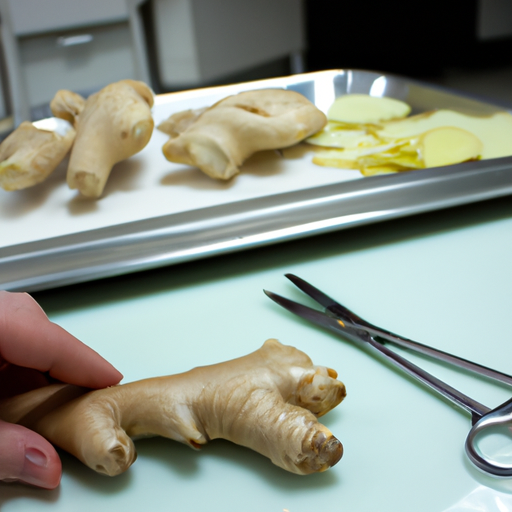As someone who prioritizes health, I am constantly seeking natural solutions to enhance my wellness. Lately, I discovered turmeric, a spice frequently found in Indian cooking, known for its various health advantages. What intrigued me was the query: is it possible to boil turmeric root and consume it?
In this article, we will explore the health benefits of turmeric, the safety of boiling turmeric root, and how to prepare turmeric tea. I will also discuss the potential benefits of drinking turmeric tea and other ways to consume turmeric.
So, let’s dive in and discover the wonders of this golden spice!
Key Takeaways
- Boiling turmeric root and drinking it is a popular trend, but consuming large amounts can lead to gastrointestinal problems.
- Turmeric contains the active compound curcumin, which has anti-inflammatory and antioxidant properties.
- Different boiling methods can affect flavor and nutritional value, and it’s important to use the right method to maximize benefits.
- It’s crucial to consume turmeric in moderation and under the guidance of a healthcare professional, and to choose a supplement with a high amount of curcumin for optimal results.
Understanding the Health Benefits of Turmeric
You can totally reap the health benefits of turmeric by adding it to your diet. Turmeric is a spice commonly used in Indian cooking, and it has been shown to have anti-inflammatory properties. Some studies have found that turmeric can be as effective as over-the-counter anti-inflammatory medications.
Turmeric is also being studied for its potential to help with a range of health issues, including Alzheimer’s disease, arthritis, and some types of cancer. However, it’s important to note that the dosage of turmeric needed to achieve these health benefits is not yet clear. Additionally, turmeric can have side effects, such as stomach upset and nausea, especially if taken in large amounts. Therefore, it’s important to talk to your healthcare provider before taking turmeric supplements or increasing your consumption of turmeric in your diet.
That being said, one popular way to consume turmeric is by boiling turmeric root in water and drinking it as a tea. But is this safe? Let’s explore this question in the next section.
Boiling Turmeric Root: Is it Safe?
Heating the yellow spice until it reaches a simmering point and then consuming it has become a popular trend among health enthusiasts. While turmeric root offers a range of health benefits, there are safety concerns that must be considered before boiling and drinking it. Turmeric contains a compound called curcumin, which has anti-inflammatory and antioxidant properties. However, consuming large amounts of turmeric can lead to gastrointestinal problems, such as acid reflux and stomach upset.
To highlight the potential risks of consuming boiled turmeric root, let’s take a look at the table below:
| Potential Benefits | Potential Risks |
|---|---|
| Anti-inflammatory properties | Gastrointestinal problems |
| Antioxidant properties | Iron deficiency |
| Improved brain function | Stomach upset |
It is important to note that while the potential benefits of consuming turmeric root are promising, it is crucial to consume it in moderation and under the guidance of a healthcare professional. Now that we have discussed the safety concerns associated with boiling turmeric root, let’s move on to the next section and learn how to properly prepare turmeric root for tea.
How to Boil Turmeric Root for Tea
When I want to make a cup of turmeric tea, I boil turmeric root to extract its healthful compounds.
To prepare the root, I wash it thoroughly and chop it into small pieces. Then, I add other ingredients like black pepper and ginger to enhance the taste and the bioavailability of turmeric.
Finally, I experiment with different recipes, such as adding honey or lemon, until I find my perfect cup of turmeric tea.
Preparing the Root
Surprisingly, boiling turmeric root isn’t as simple as throwing it in a pot of water and waiting for it to cook. There are a few steps that need to be taken before the root is ready to be boiled.
Firstly, the root needs to be peeled. This can be done using a vegetable peeler or a sharp knife. It’s important to remove the skin as it can be tough and bitter.
Once the root has been peeled, it can be sliced into thin pieces or grated using a cheese grater. The size of the pieces will affect the boiling time, so it’s important to keep this in mind.
After the root has been prepared, it can be boiled in a pot of water. The boiling time will depend on the size of the pieces. Generally, smaller pieces will take less time to cook than larger pieces.
It’s important to keep an eye on the pot and stir occasionally to prevent the root from sticking to the bottom. Once the root is soft and has turned the water a deep yellow color, it’s ready to be strained and consumed.
Adding other ingredients such as honey, lemon or ginger can enhance the flavor and provide additional health benefits.
Adding Other Ingredients
To elevate the flavor and provide additional health benefits, I always consider adding ingredients such as honey, lemon, or ginger when brewing turmeric root. These turmeric root alternatives not only add a refreshing taste but also have their own healing properties.
For instance, honey is known to have antibacterial properties, while ginger is a natural anti-inflammatory agent that aids digestion. Combining these ingredients with turmeric root creates a wholesome concoction that is both delicious and nutritious.
When it comes to brewing techniques, there are a variety of ways to prepare turmeric root with other ingredients. One of my favorite methods is to grate or crush the turmeric root and then boil it with honey, lemon, and ginger. This mixture can then be poured into a cup and enjoyed immediately while still warm.
Alternatively, you can let the mixture cool and then refrigerate it for later use. By experimenting with different brewing techniques and ingredients, you can create your own unique blend of turmeric root tea. With recipes to try, let’s explore some delicious combinations of turmeric root and other ingredients.
Recipes to Try
Get ready to tantalize your taste buds with these delectable recipes featuring the bold and vibrant flavors of turmeric paired with other wholesome ingredients.
Turmeric lattes, also known as golden milk, are a popular way to consume turmeric. To make a turmeric latte, simply heat up your preferred milk (dairy or non-dairy) in a saucepan and add turmeric powder, cinnamon, ginger, honey, and a pinch of black pepper. Whisk the mixture until it’s frothy, then pour it into a mug.
Another delicious way to incorporate turmeric into your diet is by making a turmeric smoothie. In a blender, combine frozen banana, pineapple, coconut milk, turmeric powder, ginger, and a pinch of black pepper. Blend until smooth and creamy, then pour into a glass and enjoy. These recipes are not only tasty, but also provide a variety of health benefits from the anti-inflammatory properties of turmeric.
As you sip on your turmeric latte or enjoy your turmeric smoothie, you may wonder about the specific benefits of drinking turmeric tea.
The Benefits of Drinking Turmeric Tea
I love drinking turmeric tea because of its potential benefits for my health. Turmeric contains powerful anti-inflammatory and antioxidant effects that can help reduce inflammation and oxidative stress in the body.
Studies have also shown that turmeric tea may have potential benefits for various health conditions, such as arthritis, heart disease, and even cancer.
Anti-inflammatory and Antioxidant Effects
Turmeric root is known for its powerful anti-inflammatory and antioxidant effects, making it a beneficial addition to one’s diet. While turmeric supplements are available in the market, drinking turmeric tea is a popular way to consume this spice.
To brew turmeric tea, simply boil water and add grated or ground turmeric. The tea can be sweetened with honey or lemon juice. The recommended dosage of turmeric tea is around 1-2 teaspoons of turmeric powder per cup of water.
Studies have shown that curcumin, the active compound in turmeric, has potent anti-inflammatory effects. It helps to reduce inflammation in the body, which can lead to chronic diseases like cancer, heart disease, and Alzheimer’s. Additionally, curcumin is a powerful antioxidant that helps to protect the body from damage caused by free radicals.
While more research is needed, these findings suggest that consuming turmeric may have potential benefits for various health conditions.
Potential Benefits for Various Health Conditions
Like a superhero, turmeric has the potential to aid in the prevention of chronic diseases such as cancer, heart disease, and Alzheimer’s, making it a valuable addition to your diet.
The curcumin compound found in turmeric root has been shown to possess anti-inflammatory and antioxidant properties that may be beneficial for various health conditions. In addition, turmeric root recipes are easy to make and can be incorporated into your daily routine to reap its potential health benefits.
When it comes to turmeric root dosage, it’s generally recommended to consume between 500-2000mg of curcumin per day. However, it’s important to note that the absorption of curcumin is enhanced when consumed with black pepper or fat. Therefore, adding a pinch of black pepper or cooking with a healthy fat such as coconut oil can increase the bioavailability of curcumin.
Other ways to consume turmeric include capsules, teas, and extracts.
Other Ways to Consume Turmeric
I’ve been exploring ways to incorporate turmeric into my diet, and I’ve discovered a few options beyond drinking turmeric tea.
One option is adding turmeric to my meals, which can be done by using the spice as a seasoning or adding it to sauces and marinades.
Another option is taking turmeric supplements, which can be a convenient way to ensure I’m getting enough of the active ingredient, curcumin.
However, when choosing a method, it’s important to consider factors such as dosage, quality, and potential interactions with medications.
Adding Turmeric to Food
Sprinkle some of this golden spice into your favorite dishes and experience a burst of flavor and health benefits. Turmeric seasoning has been used in traditional Indian and Middle Eastern cuisine for thousands of years, and now it has become a popular ingredient in Western dishes as well. Not only does turmeric add a unique flavor to food, but it also offers numerous health benefits such as reducing inflammation and aiding digestion.
Here are some culinary uses of turmeric that you can try at home:
| Dish | Turmeric Usage | Benefits |
|---|---|---|
| Curry | 1-2 teaspoons | Anti-inflammatory, improves digestion |
| Roasted Vegetables | Sprinkle over vegetables before roasting | Antioxidant, anti-inflammatory |
| Smoothie | Add 1 teaspoon to smoothie | Anti-inflammatory, boosts metabolism |
While adding turmeric to your food is an easy and delicious way to incorporate it into your diet, some people prefer to take turmeric supplements instead.
Taking Turmeric Supplements
Adding turmeric to food is a great way to incorporate this wonderful spice into your diet. However, sometimes it’s difficult to consume enough turmeric through food alone. That’s where turmeric supplements come in.
Turmeric supplements come in different types, such as capsules, powders, and liquids. When choosing a turmeric supplement, it’s important to read the label and make sure it contains a high amount of curcumin, the active ingredient in turmeric. The dosage recommendation for turmeric supplements can vary depending on the form and concentration, so it’s important to follow the instructions on the label or consult with a healthcare professional.
Taking turmeric supplements can provide numerous health benefits, including improved joint health, reduced inflammation, and enhanced brain function. However, it’s important to choose the right type of supplement and follow the recommended dosage to maximize these benefits.
Sub-list 1: Improved joint health
Sub-list 2: Reduced inflammation
Sub-list 3: Enhanced brain function
When considering the best method for incorporating turmeric into your diet, it’s important to take into account your personal preferences, health needs, and lifestyle. By choosing the best method for you, you can reap the many benefits of this powerful spice.
Considerations for Choosing the Best Method
When it comes to choosing the best way to incorporate turmeric into your diet, it’s important to consider your personal preferences and lifestyle. Boiling turmeric root and drinking it is one way to consume this spice, but there are different boiling methods that can affect the flavor and nutritional value.
For example, some people prefer boiling fresh turmeric root in water and adding honey or lemon for taste, while others prefer boiling dried turmeric powder in milk or coconut milk for a creamy texture. In addition to flavor variations, it’s important to consider the health benefits of turmeric when choosing the best boiling method.
Boiling turmeric can release the active compound curcumin, which has anti-inflammatory and antioxidant properties. However, curcumin is not easily absorbed by the body and can be degraded by heat, so it’s important to use the right boiling method to maximize its benefits.
Overall, boiling turmeric root can be a healthy and flavorful way to incorporate this spice into your diet, but it’s important to experiment with different boiling methods and consult with a healthcare professional to ensure optimal results.
Frequently Asked Questions
Can boiled turmeric root be used for skin care?
Turmeric root is known for its skin benefits and is often used in facial masks. It contains antioxidants and anti-inflammatory properties that can help brighten and even out skin tone, reduce acne and wrinkles. However, boiling turmeric root for skin care may not be as effective as using turmeric powder or extracts.
Does boiling turmeric root remove all of its health benefits?
Boiling turmeric root may reduce some of its health benefits, but incorporating turmeric into your diet through cooking or taking turmeric supplements can still provide numerous health benefits such as anti-inflammatory properties and improved cognitive function.
How long should I boil turmeric root for maximum health benefits?
As if boiling turmeric root for maximum health benefits wasn’t complicated enough, adding ingredients to my turmeric tea while boiling made it even more daunting. However, boiling for 10-15 minutes should suffice.
Can I add other ingredients to my turmeric tea while boiling the root?
Yes, I recommend adding spice blends like ginger and cinnamon to enhance the flavor and health benefits of turmeric tea. Alternative sweeteners like honey or stevia can also be added while boiling the root.
Are there any potential side effects of drinking boiled turmeric root tea?
Before drinking boiled turmeric root tea, it’s important to consider possible risks and take precautions. While there are many benefits to boiling turmeric root for tea, it can also lead to side effects if consumed excessively or in combination with certain medications.
Conclusion
Well, folks, I’ve researched and experimented, and I’ve concluded that boiling turmeric root and drinking it is not only safe but also incredibly beneficial for our health. Turmeric has anti-inflammatory and antioxidant properties and has been used for centuries in Ayurvedic and Chinese medicine to treat various ailments. Scientific studies have confirmed its effectiveness in preventing and treating chronic diseases, such as cancer, heart disease, and Alzheimer’s.
But, before you start boiling away, make sure to follow the proper steps to prepare your turmeric tea. First, wash and peel the turmeric root, then grate or chop it into small pieces. Next, add it to a pot of boiling water and let it simmer for 10-15 minutes. Strain the mixture and add honey or lemon juice for taste, if desired.
Voila! You now have a delicious and nutritious cup of turmeric tea. Drinking turmeric tea is just one of the many ways to incorporate this superfood into your diet. You can also add turmeric powder to your smoothies, soups, and curries. So, why not give it a try? Your body will thank you for it. After all, as the saying goes, "an ounce of prevention is worth a pound of cure."










